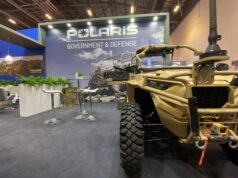The Dutch Safety Board has published their report on the fate of Malaysian Airlines Flight MH17 that was shot down in 2014 over Ukraine.
The report has found that the aircraft was shot down by a Russian made Buk missile. The Buk missile system is a medium-range surface-to-air missile system in use by Russia, Ukraine, some former Soviet states and many other nations.
In June this year, Mikhail Malisevskiy, chief engineer at Almaz-Antey who manufacture the Buk missile system announced that the company’s own analysis of the pattern of damage seen on pieces of MH17 wreckage, suggested that the aircraft had been shot down by a Buk missile.
![Buk air defence systems at a static display at the Engineering technologies 2010 exposition. Photo by Vitaly V. Kuzmin (http://vitalykuzmin.net/?q=node/313; exact source) [CC BY-SA 3.0 (http://creativecommons.org/licenses/by-sa/3.0) or CC BY-SA 3.0 (http://creativecommons.org/licenses/by-sa/3.0)], via Wikimedia Commons.](https://ukdefencejournal.org.uk/wp-content/uploads/2015/10/Buk-M1-2_air_defence_system_in_2010-1024x646.jpg)
The company Have also said that the missile involved must have been a 9M38 variant of missile and that only Ukraine has these, there has been no confirmation of this independently.
The Buk system also saw use in the Russian-Georgian conflict in 2008 where analysts concluded that Georgian Buk missile systems were responsible for downing four Russian aircraft, three Sukhoi Su-25 close air support aircraft and a Tupolev Tu-22M high-altitude strategic bomber.
Preliminary findings presented in September 2014 claimed the aircraft was hit by “high-energy objects from outside the aircraft”, fuelling speculation that a surface to air missile was responsible.
Malaysia Airlines Flight MH17 was a flight from Amsterdam to Kuala Lumpur that crashed on 17 July 2014 after being shot down, killing all 283 passengers and 15 crew on board. Authorities lost contact with the Boeing 777 about 50km from the Ukraine–Russia border.
[su_pullquote align=”right”]The final report did not apportion blame as the board does not have the authority to apportion blame.[/su_pullquote]
The safety board also showed parts of the aircraft that had been brought back from the rebel-held Donetsk region and reconstructed.
Recovery of the wreckage of flight MH17, a task commissioned by the Dutch Safety Board, began at the crash site in November 2014. To enable the recovery of wreckage, the board agreed certain arrangements with the Ukraine State Emergency Service assistance. A document has been published concerning the recovery of the wreckage.
An independent analysis earlier in the year by Bellingcat of open-source evidence indicated that Russian-backed separatists were in control of a Buk missile launcher on 17 July and transported it from Donetsk to Snizhne, while three eyewitnesses told the BBC that such a missile launcher was operated by a crew that seemed to be Russian in the area on that date.
It was reported in December of last year that Ukrainian authorities claimed that some of the bodies found at the crash location contained metallic fragments that supposedly indicate the aircraft had been impacted by a missile. Early preliminary evidence from the Dutch investigation had suggested that the aircraft was most likely downed by a Russian unit that was “probably” manned by a Russian crew, though other possibilities were not ruled out at the time. In August this year, possible missile parts were found at the crash site by a joint investigation team comprising representatives of the Netherlands, Ukraine, Malaysia, Australia, the UK, US and Russia.
Board president Djibbe Joustra said there had been sufficient reason to close off Ukrainian airspace but Ukraine did not do that – and on the day of the crash, 160 flights flew over the area in question.
The final report did not apportion blame as the board does not have the authority to apportion blame under the rules governing international flight crash investigations. A separate criminal investigation is expected to publish its findings within the next few months.





